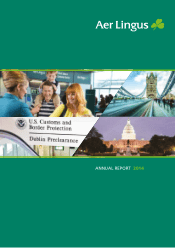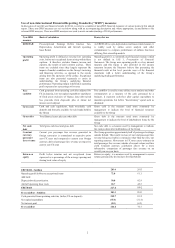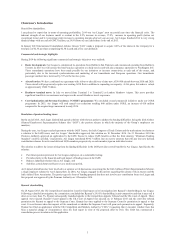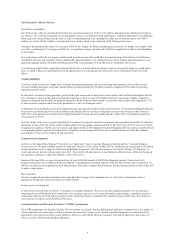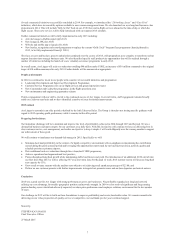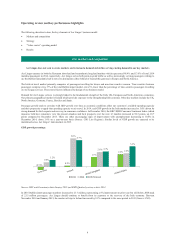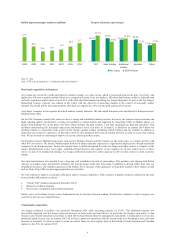Aer Lingus 2014 Annual Report Download - page 4
Download and view the complete annual report
Please find page 4 of the 2014 Aer Lingus annual report below. You can navigate through the pages in the report by either clicking on the pages listed below, or by using the keyword search tool below to find specific information within the annual report.
2
Use of non-International Financial Reporting Standards (“IFRS”) measures
In discussion of our full year financial results for 2014, we refer to a number of non-IFRS financial measures at various points in this annual
report. These non-IFRS measures are set out below along with an accompanying description and where appropriate, reconciliation to the
relevant IFRS measure. These non-IFRS measures are used to assist an understanding of 2014 performance.
Non-IFRS
measure
Basis of calculation
Reason for use
EBITDAR
Pre-exceptional Earnings Before Interest, Tax,
Depreciation, Amortisation and Aircraft operating
lease Rental
As EBITDAR is a pre-depreciation and lease rental measure, it
is widely used by airline sector analysts and other
commentators to compare performance of airlines that have
differing fleet ownership models
Operating
profit
Operating profit is defined as revenue less operating
costs, before net exceptional items arising within these
captions. It therefore excludes finance income and
expense, the results of joint ventures and tax. These
items are excluded since they largely represent the
impact of market conditions on the Group’s investing
and financing activities, as opposed to the results
arising from the operation of the airline. Exceptional
items are also presented separately to assist in
understanding the Group’s underlying financial
performance. Operating margin is defined as operating
profit expressed as a percentage of revenue
Operating profit is a commonly used financial measure which
is not defined in IAS 1, Presentation of Financial
Statements. The Group uses operating profit as a key internal
measure and this figure is also provided in the income
statement because the Directors believe that presenting the
financial result at this level provides users of the financial
statements with a better understanding of the Group’s
underlying trading performance
Free
cashflow
Cash generated from operating activities adjusted for
FX in deposits, less net capital expenditure (purchases
of fixed assets exclusive of finance lease debt raised
less proceeds from disposals) plus or minus net
interest received/paid
Free cashflow is used by some airline sector analysts and other
commentators as a measure of the cash generated by a
business. It measures cash flow after capital expenditure to
maintain operations but before “discretionary” spend such as
dividends
Gross cash
Cash and cash equivalents, bank overdrafts, cash
deposits and formerly available for sale bonds held by
the Group
Gross cash is the measure used most commonly by
management to indicate the level of financial resources
available to the Group
Gross debt
Total finance leases plus any other debt
Gross debt is the measure used most commonly by
management to indicate the level of indebtedness borne by the
Group
Net cash/
debt
Total gross cash less total gross debt
Net cash/ debt is a measure used by management to indicate
the cash position after indebtedness of the Group
Constant
currency
passenger
fare revenue
Current year passenger fare revenue generated in
foreign currencies is retranslated at respective prior
year FX rates and compared to current year foreign
currency derived passenger fare revenue at respective
current year FX rates
The Group generates approximately half of passenger bookings
outside Ireland. This results in more of our total passenger fare
revenue being receivable in currencies other than the euro, our
reporting currency. Movements in FX rates cause variances in
total passenger fare revenue outside of normal volume and fare
yield. Constant currency calculation allows for a more
informative comparison of passenger fare revenue on an
overall year-on-year basis
Return on
equity
Profit before taxation and net exceptional items
expressed as a percentage of the average opening and
closing book value of equity
Return on equity is a measure used by management to assess
returns generated by the business for shareholders
EBITDAR - €million
2014
2013
Operating profit before net exceptional items
72.0
61.1
Add back:
Depreciation & amortisation
90.0
82.9
Aircraft operating lease costs
65.7
45.2
EBITDAR
227.6
189.2
Free cashflow - €million
2014
2013
Cash generated from operating activities (before FX on deposits)
202.7
112.2
Net capital expenditure
(55.3)
(31.4)
Net interest paid
(0.8)
(4.5)
Free cashflow
146.6
76.3

